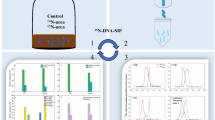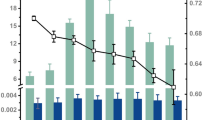Abstract
Microbial communities from riparian sediments contaminated with high levels of Ni and U were examined for metal-tolerant microorganisms. Isolation of four aerobic Ni-tolerant, Gram-positive heterotrophic bacteria indicated selection pressure from Ni. These isolates were identified as Arthrobacter oxydans NR-1, Streptomyces galbus NR-2, Streptomyces aureofaciens NR-3, and Kitasatospora cystarginea NR-4 based on partial 16S rDNA sequences. A functional gene microarray containing gene probes for functions associated with biogeochemical cycling, metal homeostasis, and organic contaminant degradation showed little overlap among the four isolates. Fifteen of the genes were detected in all four isolates with only two of these related to metal resistance, specifically to tellurium. Each of the four isolates also displayed resistance to at least one of six antibiotics tested, with resistance to kanamycin, gentamycin, and ciprofloxacin observed in at least two of the isolates. Further characterization of S. aureofaciens NR-3 and K. cystarginea NR-4 demonstrated that both isolates expressed Ni tolerance constitutively. In addition, both were able to grow in higher concentrations of Ni at pH 6 as compared with pH 7 (42.6 and 8.5 mM Ni at pH 6 and 7, respectively). Tolerance to Cd, Co, and Zn was also examined in these two isolates; a similar pH-dependent metal tolerance was observed when grown with Co and Zn. Neither isolate was tolerant to Cd. These findings suggest that Ni is exerting a selection pressure at this site for metal-resistant actinomycetes.



Similar content being viewed by others
References
Amoroso, MJ, Schubert, A, Mitscherlich, P, Schumann, P, Kothe, E (2000) Evidence for high affinity nickel transporter genes in heavy metal resistant Streptomyces spec. J Basic Microbiol 40: 295–301
Babich, H, Stotzky, G (1982) Nickel toxicity to microbes: effect of pH and implications for acid rain. Environ Res 29: 335–350
Babich, H, Stotzky, G (1983) Temperature, pH, salinity, hardness, and particulates mediate nickel toxicity to eubacteria, an actinomycete, and yeasts in lake, simulated estuarine, and sea waters. Aquat Toxicol 3: 195–208
Bitton, G, Garland, E, Kong, IC, Morel, JL, Koopman, B (1996) A direct solid-phase assay for heavy metal toxicity. I. Methodology. J Soil Contam 5: 385–394
Bitton, G, Jung, K, Koopman, B (1994) Evaluation of a microplate assay specific for heavy metal toxicity. Arch Contam Toxicol 27: 25–28
Bradford, MM (1976) A rapid and sensitive method for quantification of microgram quantities of protein utilizing the principle of protein–dye binding. Analyt Biochem 72: 248–254
Dobrindt, U, Hochhut, B, Hentschel, U, Hacker, J (2004) Genomic islands in pathogenic and environmental microorganisms. Nat Rev Microbiol 2: 414–424
Evans, AG, Bauer, LR, Haselow, Hayes DW, Martin, HL, McDowell, WL, Picket, JB (1992) Uranium in the Savannah River Site environment. Westinghouse Savannah River Company, Report WSRC-RP-92-315, Aiken, SC
Everis, L, Betts, G (2001) pH stress can cause cell elongation in Bacillus and Clostrdium species: a research note. Food Control 12: 53–56
Fay, W, VanSickle, L, Williams, J (1997) In: Arnett, MW, Mamatey, AR (Eds.) Savannah River Site Environmental Report for 1996, Technical Report WSRC-TR-97-0171, Westinghouse Savannah River Company, Aiken, SC
Ferris, MJ, Muyzer, G, Ward, DM (1996) Denaturing gradient gel electrophoresis profiles of 16S rRNA-defined populations inhabiting a hot spring microbial mat community. Appl Environ Microbiol 62: 370–378
Giller, KE, Witter, E, McGrath, SP (1998) Toxicity of heavy metals to microorganisms and microbial processes in agricultural soils: a review. Soil Biol Biochem 30: 1389–1414
Grass, G, Fan, B, Rosen, BP, Lemke, K, Schlegal, HG, Rensing, C (2001) NreB from Achromobacter xylosoxidans 31A is a nickel-induced transporter conferring nickel resistance. J Bacteriol 183: 2803–2807
Hagedorn, C, Holt, JG (1975) Ecology of soil Arthrobacters in Calrion–Webster toposequences of Iowa. Appl Microbiol 29: 211–218
Hall, TA (1999) BioEdit: a user friendly biological sequence alignment editor and analysis program for Windows 95/98/NT. Nucleic Acids Symp Ser 41: 95–98
HazDat (2005) Agency for Toxic Substances and Disease Registry (ATSDR), Atlanta, GA. www.atsdr.cdc.gov/supportdocs/appendix-a.pdf
Hebbeln, P, Eitinger, T (2004) Heterologous production and characterization of bacterial nickel/cobalt permeases. FEMS Microbiol Lett 230: 129–135
Hery, M, Nazaret, S, Jaffre, T, Normand, P, Navarro, E (2003) Adaptation to nickel spiking of bacterial communities in neocaldonian soils. Environ Microbiol 5: 3–12
Higham, DP, Sadler, PJ, Scawen, MD (1985) Cadmium resistance in Pseudomonas putida: growth and uptake of cadmium. J Gen Microbiol 131: 2539–2544
Idris, R, Trifonova, R, Puschenreiter, M, Wenzel, WW, Sessitsch, A (2004) Bacterial communities associated with flowering plants of the Ni hyperaccumulator Thlaspi goesingense. Appl Environ Microbiol 70: 2667–2677
Isaac, SR, Nair, MA (2005) Biodegradation of leaf litter in the warm humid tropics of Kerala, India. Soil Biol Biochem 37: 1656–1664
Jackson, DG, Noonkester, JV, Vangelas, KM (2000) Characterization activities to evaluate chlorinated solvent discharges to Tims Branch from the A/M area of the Savannah River Site, Technical Report WSRC-TR-2000-00472, Westinghouse Savannah River Company, Aiken, SC
Li, X, He, Z, Zhou, J (2005) Selection of optimal oligonucleotide probes for microarrays using multiple criteria, global alignment and parameter estimation. Nucleic Acids Res 33: 6114–6123
Liebich, J, Schadt, CW, Chong, SC, He, Z, Rhee, SK, Zhou, J (2006) Improvement of oligonucleotide probe design criteria for functional gene microarrays in environmental applications. Appl Environ Microbiol 72: 1688–1691
Loureiro, S, Ferreira, ALG, Soares, AMVM, Nogueira, AJA (2005) Evaluation of the toxicity of two soils from Jales Mine (Portugal) using aquatic bioassays. Chemosphere 61: 168–177
Maidak, BL, Cole, JR, Parker, CT Jr, Garrity, GM, Larsen, N, Li, B, Lilburn, TG, McCaughey, MJ, Olsen, GJ, Overbeek, R, Pramanik, S, Schmidt, TM, Tiedje, JM, Woese, CR (1999) A new version of the RDP (ribosomal database project). Nucleic Acids Res 27: 171–173
Margesin, R, Schinner, F (1996) Heavy metal resistant Arthrobacter sp.—a tool for studying conjugational plasmid transfer between gram-negative and gram-positive bacteria. J Basic Microbiol 36: 269–282
McArthur, JV, Tuckfield, RC (2000) Spatial patterns in antibiotic resistance among stream bacteria: effects of industrial pollution. Appl Environ Microbiol 66: 3722–3726
McCarthy, AJ, Williams, ST (1992) Actinomycetes as agents of biodegradation in the environment—a review. Gene 115: 189–192
Mengoni, A, Barzanti, R, Gonnelli, C, Gennrielli, R, Bazzicalupo, M (2001) Characterization of nickel-resistant bacteria isolated from serpentine soil. Environ Microbiol 3: 691–698
Mergeay, M, Houba, C, Gerits, J (1978) Extrachromosomal inheritance controlling resistance to cadmium, cobalt, copper, and zinc ions: evidence from curing in a Pseudomonas. Arch Int Physiol Biochim 86: 440–441
Muyzer, G, DeWall, EC, Uitterlinden, AG (1993) Profiling of complex microbial populations by denaturing gradient gel electrophoresis analysis of polymerase chain reaction-amplified genes coding for 16S rRNA. Appl Environ Microbiol 59: 695–700
Nies, DH (2003) Efflux-mediated heavy metal resistance in prokaryotes. FEMS Microbiol Rev 27: 313–319
Nies, D, Mergeay, M, Friedrich, B, Schlegel, HG (1987) Cloning of plasmid genes encoding resistance to cadmium, zinc, and cobalt in Alcaligenes eutrophus CH34. J Bacteriol 169: 4865–4868
Nies, D, Nies, A, Chu, L, Silver, S (1989) Expression and nucleotide sequence of a plasmid-determined divalent cation efflux system from Alcaligenes eutrophus. Proc Natl Acad Sci 86: 7351–7355
Pickett, JB, Colven, WP, Bledsoe, HW (1987) Environmental information document: M-area settling basic and vicinity, Report DPST-85-703, E. I. du Pont Nemours & Co, Aiken, SC
Rhee, SK, Liu, Z, Wu, L, Chong, SC, Wan, X, Zhou, J (2004) Detection of genes involved in biodegradation and biotransformation in microbial communities by using 50-mer oligonucleotide microarrays. Appl Environ Microbiol 70: 4303–4317
Riley, RG, Zachara, JM, Wobber, FJ (1992) Chemical contamination on DOE lands and selection of contaminated mixtures for subsurface science research, Rep. DOE/ER-0547T, U.S. Department of Energy, Washington, DC
Schlegel, HG, Cosson, JP, Baker, AJM (1991) Nickel-hyperaccumulating plants provide a niche for nickel-resistant bacteria. Bot Acta 104: 18–25
Schmidt, T, Schlegel, HG (1994) Combined nickel–cobalt–cadmium resistance encoded by the ncc locus of Alcaligenes xylosoxydans 31A. J Bacteriol 176: 7045–7054
Schmidt, T, Stoppel, RD, Schlegel, HG (1991) High-level nickel resistance in Alcaligenes xylosoxydans 31A and Alcaligenes eutrophus KTO2. Appl Eviron Microbiol 57: 3301–3309
Silver, S, Phung, LT (2005) A bacterial view of the periodic table: genes and proteins for toxic inorganic ions. J Ind Microbiol Biotechnol 32: 587–605
Smalla, K, Woeland, G, Buchner, A, Zock, A, Parzy, J, Kaier, S, Roskot, N, Heuer, H, Berg, G (2001) Bulk and rhizosphere soil bacterial communities studied by denaturing gradient gel electrophoresis: plant-dependent enrichment and seasonal shifts revealed. Appl Environ Microbiol 67: 4742–4751
Sowder, AG, Bertsch, PM, Morris, PJ (2003) Partitioning and availability of uranium and nickel in contaminated riparian sediments. J Environ Qual 32: 885–898
Stanier, R, Palleroni, N, Douderouf, M (1966) The aerobic Pseudomonads: a taxonomic study. J Gen Microbiol 43: 159–271
Stepanauskas, R, Gless, T, Jagoe, C, Tuckfield, RC, Lindell, A, McArthur, JV (2005) Elevated microbial tolerance to metals and antibiotics in metal-contaminated industrial environments. Environ Sci Technol 39: 3671–3678
Stoppel, T, Schlegel, HG (1989) Nickel and cobalt resistance of various bacteria isolated from soil and highly polluted domestic and industrial wastes. FEMS Microbiol Ecol 62: 315–328
Stoppel, RD, Schlegel, HG (1995) Nickel-resistant bacteria from anthropogenically nickel-polluted and naturally nickel-percolated ecosystems. Appl Environ Microbiol 61: 2276–2285
Summers, AO (2002) Generally overlooked fundamental bacterial genetics and ecology. Clin Infect Dis 34: S85–92
Suutari, M, Lignell, U, Hirvonen, MR, Nevalainen, A (2000) Growth pH ranges of Streptomyces spp. ASM News 66: 588–589
Swofford, DL (2002) PAUP* Pylogenetic analysis using parsimony (and other methods), 4.0 ed, Sinaur, Sunderland, MA
Taghavi, S, Delanghe, H, Lodewyckx, C, Mergeay, M, Van der Lelie, D (2001) Nickel-resistance-based minitransposons: new tools for genetic manipulation of environmental bacteria. Appl Environ. Microbiol 67: 1015–1019
Van Nostrand, JD, Khijniak, TV, Sowder, A, Bertsch, PM, Morris, PJ (2005) The effect of pH on the toxicity of nickel and other divalent metals to Burkholderia cepacia PR1301. Environ Toxicol Chem 22: 2742–2750
Warren, R, Hsiao, WWL, Kudo, H, Myhre, M, Dosanjh, M, Petrescu, A, Kobayashi, H, Shimizu, S, Miyauchi, K, Masai, E, Yang, G, Stott, JM, Schein, JE, Shin, H, Khattra, J, Smailus, D, Butterfield, YS, Siddiqui, A, Holt, R, Marra, MA, Jones, SJM, Mohn, WM, Brinkman, FSL, Fukuda, M, Davies, J, Eltis, LD (2004) Functional characterization of a catabolic plasmid from polychlorinated-biphenyl-degrading Rhodococcus sp. strain RHA1. J Bacteriol 186: 7783–7795
Wilson, K (1994) Preparation of genomic DNA from bacteria. In: Ausubel, FA, Brent, R, Kingston, RE, Moore, DD, Seidman, JG, Smith, JA Struhl, K (Eds.) Current protocols in molecular biology, John Wiley & Sons, New York, pp 2.4.1–2.4.5
Wireman, J, Liebert, CA, Smith, T, Summers, AO (1997) Association of mercury resistance with antibiotic resistance in the Gram-negative fecal bacteria of primates. Appl Environ Microbiol 63: 4494–4503
Acknowledgments
We thank J. V. McArthur and A. Lindell, Savannah River Ecology Laboratory, University of Georgia, for performing the antibiotic resistance assays. This research was supported by grants from the EPA/DOE/NSF/ONR Joint Program on Bioremediation administered by the DOE, Office of Biological and Environmental Research (ER62696-1011950-0003828), the DOE Environmental Management Science Program (ER086845-0007743), and by Financial Assistance Award DE-FC09-96SR18546 from the DOE Office of Biological and Environmental Research, Environmental Remediation Sciences Division to the University of Georgia Research Foundation. M.N. was supported by a Medical University of South Carolina doctoral fellowship and J.V.N. was supported by a U.S. Environmental Protection Agency Science to Achieve Results Graduate Fellowship and the Savannah River Ecology Laboratory Graduate Research Participation Program. The microarray experiments were supported by the DOE under the Natural and Accelerated Bioremediation Research Program of the Office of Biological and Environmental Research, Office of Science. Oak Ridge National Laboratory is managed by the University of Tennessee-Battelle LLC for the DOE under contract DE-ACo5-00OR22725.
Author information
Authors and Affiliations
Corresponding author
Rights and permissions
About this article
Cite this article
Van Nostrand, J.D., Khijniak, T.V., Gentry, T.J. et al. Isolation and Characterization of Four Gram-Positive Nickel-Tolerant Microorganisms from Contaminated Sediments. Microb Ecol 53, 670–682 (2007). https://doi.org/10.1007/s00248-006-9160-7
Received:
Revised:
Accepted:
Published:
Issue Date:
DOI: https://doi.org/10.1007/s00248-006-9160-7




